I don’t remember playing in the garden. More often we played in the vacant lot behind the garage. Houses have been built there now, but during the war it was just a rough field. We played with an American football; just kicking the ball around, nothing more, though the boys tackled each other. We also dug tunnels and took oranges and candy to hide in them. In the winter all of the neighbourhood children gathered in the lot for snowball fights, which I hated. We built walls of snow that were fortresses to hide behind. We made loads of snowballs and then charged the enemy. They did the same to us of course. I remember being hit in the eye by a snowball.
We all three had bikes, the sort where you pedal backwards to slow down. Mine had balloon tyres(1). In the summer we cycled a couple of miles down Penfield Road and then pushed them across a field to a creek lined with trees. Branches hung out over the water and it was fun to drop into the creek from them. We splashed about and “swam” after a fashion. The bottom was muddy and not very pleasant but we had fun. There was a lot of freedom in those days and no warnings about unsavoury characters or dangers of any sort. Once I was in the water and found a leach had fastened itself onto my leg near my ankle. I don’t think I went in that water again.
The only thing forbidden was going onto the railway track that ran between the house and our school. That didn’t stop some boys from placing pennies on the track and then picking them up when the coins had been flattened by a train.
At the other end of Greenaway Road lived the Ogdens, a family with 4 girls. There was Helen, Polly and Cricket in descending order
of age and an older girl whose name I don’t know. In their garden was a lovely cherry tree. We were allowed to climb it and eat the
cherries. Cricket [real name Virginia] was my age and Polly a little older. Both were pretty girls and Teddy had a crush on Polly.
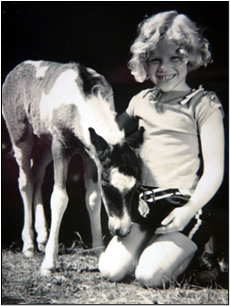
Cricket with her pony.
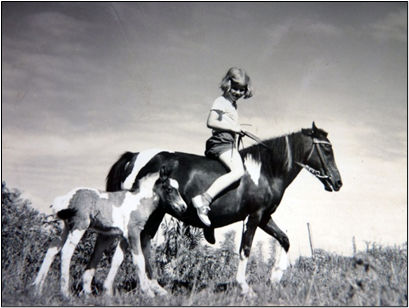
Holly with her horse.
In the garden to the side of their house was a lovely cherry tree. It was fully grown and easy to climb, with or without cherries. That was fun. They also had a trapeze and I enjoyed hanging upside down by my ankles and swinging.
A favourite indoor game was jigsaw puzzles. I had enjoyed these in England and I still do.
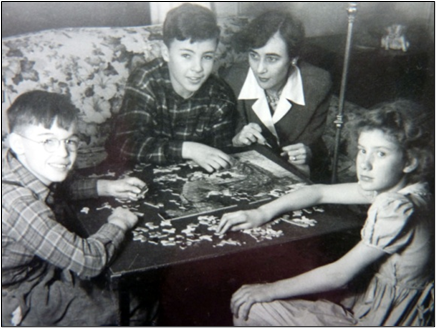
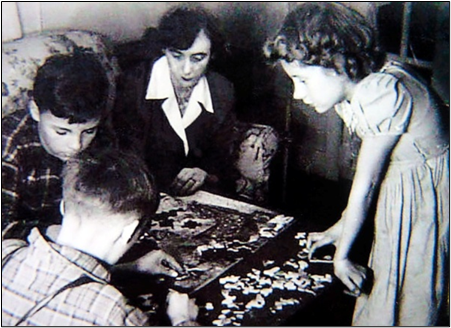
Doing a jigsaw together.
As I have said, my piano lessons were soon stopped but there is one picture of me at the piano.

Pretending to play the piano
I deliberately put my hands in an awkward position with my thumbs hanging down so that anybody would know I was not really playing.
The photographer, [Carl or Mary] didn’t notice but I hoped my parents back in England would when they received their copy. They never
said anything about it so presumably they didn’t notice.
First there was Mickey. Mary and Carl had driven down to Pemberton, NJ to pick us up from the farm at the end of our few weeks summer
holiday there. On the way back they told us they had bought a puppy and we had to guess his name. They made it easy to guess it was
Mickey. He didn’t live long as he developed chorea and died from it.
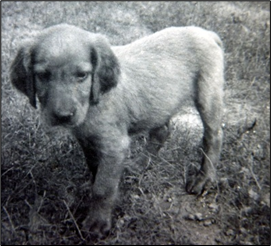
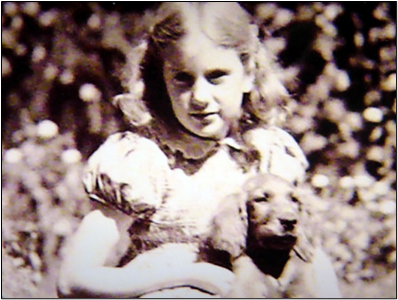
Mickey.
Then there was his replacement, another Irish setter we named Corky. Corky lived longer but was run over.
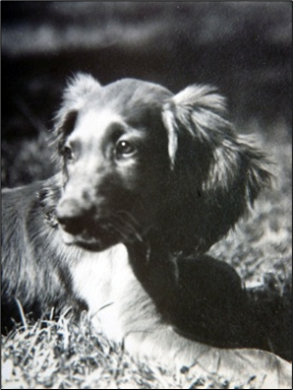
Corky.
Lastly there was a fine pedigree Dalmatian, Smokey Joe. He was there when I had to return to England in 1945. I missed him.
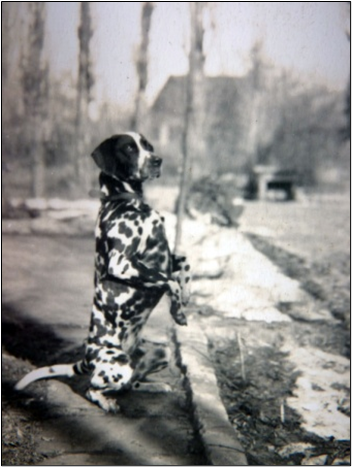
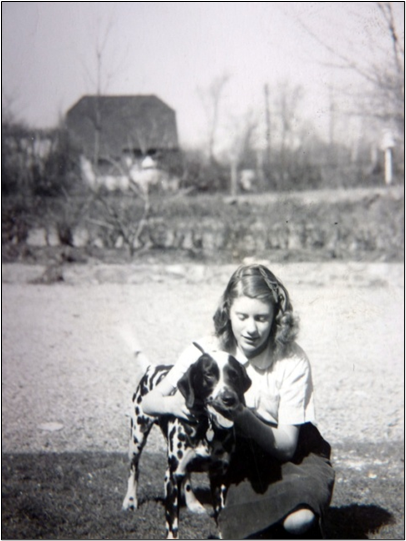
Smokey Joe.
I don’t know what happened to Smokey after I returned to England. Mary said she told my parents that I would settle better if they got me a dog as I had always been used to them. But that didn’t happen. I don’t think we could have afforded to keep a dog in Harrow Weald. It was still very austere just after the war and my mother was too houseproud to keep any animal in the house anyway.
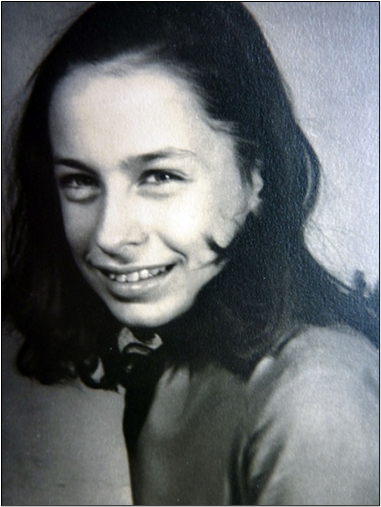
My 7th grade friend, Margaret de Lyser.
We spent many Saturday afternoons going to the cinema together so she must have been approved. Another girl named Frances Rasch was
not approved because her father was a taxi driver, not classy enough for Mary, who was a snob. This attitude was without doubt taught
to her by her mother, Nanna Anne. Nanna Anne had never approved of Mary’s marriage to Carl H Grashof Jr. who did not go to one of
the “best universities” [only Rochester]. Nanna Anne considered Rochester to be a “one horse town”.
The summer holidays were very long, nearly always beginning just before my birthday in June. We were sent to camp for two weeks
each year after I was 9, which was really fun. Teddy and Sandy went to a boys camp, run I think by the YMCA(2). I had joined the Girl
Scouts and went to Camp Beechwood on the shores of Lake Ontario. We slept in permanent tents with wooden floors, 4 to a tent, and
did a variety of activities. These included swimming lessons in the lake, canoeing, and archery, as well as crafts and softball.
There were singsongs around the camp fire in the evenings. It was all great fun.

Summer camp.
It was here when I was 11 that I first heard the “facts of life” which my tent mates, who were all a little older than me, thought I should have known already. I remember one of them saying that Mary could not be a very good mother for a girl of my age. After a lot of giggling one of them said “The man puts his thingamajig in the woman’s thingamajig” and they all burst out laughing. My reaction [unspoken] was that it had nothing to do with me and I was not at all interested in what they did. I remember thinking, “Well so what?” In fact that was my first and last instruction in the subject as it was not taught in school in those days and my mother did not talk about things like that... ever.
Ted and Sandy were sent to a YMCA camp, which I think may have been somewhere in the Finger Lakes region of New York.
The farm in question was Pine Cottage Farm in Pemberton, New Jersey. We spent several weeks there each summer, having been driven the 360 odd miles from Rochester. The route took us past the Finger Lakes, around New York City and then south into New Jersey. It was a very long time for 3 children to sit on the back seat and there were the inevitable squabbles and pinching. We may have taken another route once because I remember stopping to look at brown bears by the side of the road, north of New York City.
Pine Cottage Farm was owned and managed by Mary’s mother, Anna Gautier, whom we called Nanna Anne. She was a widow who had been married 3 times, her last husband being Mr Gautier presumably as she was Mrs Gautier. He must have been wealthy because, as well as the farm, she owned an apartment in the Plaza Hotel in New York. Her friends were all “upper class” and rich. One of them, named Madeleine, lived in Philadelphia and had a married daughter named Libby. I had a regular supply of clothes that came from “Libby’s little girl”. The clothes would arrive in Rochester mysteriously once or twice a year, but I never met her.
Nanna Anne was what is called a “character”, a very powerful woman whom you disobeyed at your peril. There were 2 men who lived on the 52-acre farm as “help”; a young man called Ralph, and an older man called Platty who was about 60. They did all the work, but Nanna Anne was not afraid to join them and get her hands dirty. One extra hot summer Platty had heat stroke. I remember him lying in bed almost delirious in a darkened room and Nanna Anne sitting there and holding an ice pack on his forehead.
Nanna Anne would drive a pick-up truck into Pemberton for supplies, and sometimes to Trenton [the New Jersey capital]. After one trip we were back at the farm, just approaching the house. I was sitting on the side at the back in the open with Ted and Sandy. As we went slowly round a slight bend I fell off backwards onto the gravel drive and badly grazed my shoulder. It could have been worse.
There was also a tractor of course and various other bits of farm machinery. There were around 40 cows, some of which at any rate were Jerseys. When they had calves the mother and calf were tethered in the front garden and we could pet them. The calves had such soft muzzles even if they were rather slobbery. I was taught how to milk a cow but was not very good at it. Hens ran freely all over the farmyard and we got to know where they laid their eggs and collected them each morning. A small machine about the size of a tricycle took the kernels off the corn cobs. I think this was called shucking the corn. You fed the cob in one end, turned a handle, and the kernels came out the other end to be collected in a bag. We were allowed to do this and feed the hens with the corn.
Between the main road and the house was a large field of maize so there was always really fresh corn to eat in the summer. I don’t know what grew in the other fields. I never went to them.
The barn was a good place to play. You could climb up into the hay loft and jump down into soft hay on the barn floor below. No health and safety issues to spoil our fun in those days. It was also good to burrow into it and hide or toss it about. Goodness knows how many little creatures lived in the hay and were frightened.
Towards the end of the war, when we were bigger, Nanna Anne used to take us to another farm each weekday where we were employed in picking blueberries. It was hot work and we were there for hours. I think we began at 10 and finished at 5. Of course we earned money for doing this but it was “put into savings” for us. I don’t know if Ted or Sandy ever saw any of the hard earned money but I certainly did not. There were stand pipes in the fields and I thought the water from them tasted of eggs. I didn’t like it at all but had to drink it as it was that or go thirsty.
Across the road from the farm there was a deep disused quarry, full of water. We were strictly forbidden to swim in it unless we were taken by an adult and it must have been very dangerous. One day we did manage to go there alone and swim. Of course we were found out and retribution was swift... no more swimming anywhere for a month.
A safer place to swim was in the indoor swimming pool of a posh hotel in Atlantic City, which is about 60 miles away on the New Jersey coast. A few times Nanna Anne drove us there and we had proper lessons. I remember wearing a belt with a long rope attached and swimming round the perimeter of the pool with the instructor holding the rope. I also remember staying overnight at the hotel on one occasion.
Not far from Pemberton was/is Fort Dix. Nanna Anne had friends there. She took us there to attend the funeral of one, a Colonel. I think it was a natural death but may have been a consequence of the war. I was quite unmoved by the sight of the corpse in the open casket. I had never known him alive. I didn’t see another dead body until the funeral of my sister’s son, Stephen, aged 12, in 1968. That moved me to tears.
Mrs Powell was Nanna Anne’s mother and I remember her living at the farm when I first went there. I know she was not there in the last year of the war [1944], so I suppose she died, but nothing was ever said about her death. She was a very formal old fashioned lady and I liked her. When we met her the boys had to bow and shake hands and I had to curtsey. She always addressed people as thou and thee, which was fascinating to me. I picture her sitting in her rocking chair. I have no real idea how old she was, probably in her late 70s.
Mostly our summer holidays were very happy. In 1983[?] Mervyn and I visited Ted and his Finnish wife, Anita in Chatham, New Jersey.
One day he drove us to Pemberton to see the farm. It was very much changed.

The farm in Pemberton in the 1980s.
I slept in the room upstairs on the left. I was in a single bed and Nanna Anne had her double. She always used to make me sleep on my
right hand side because she said it was bad for your heart to sleep on your left side.